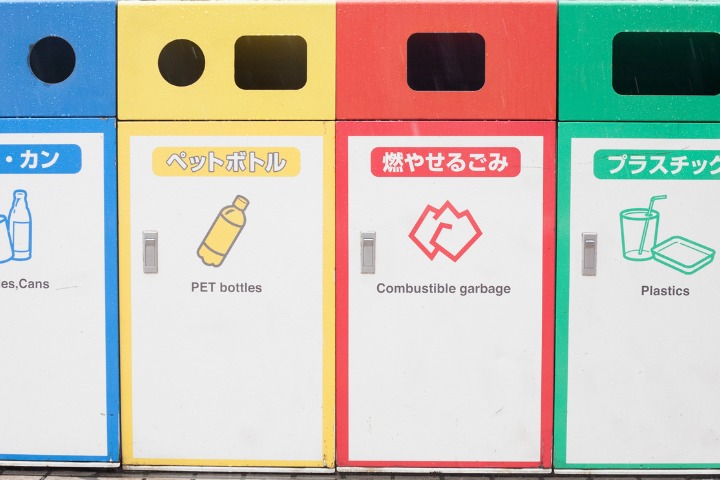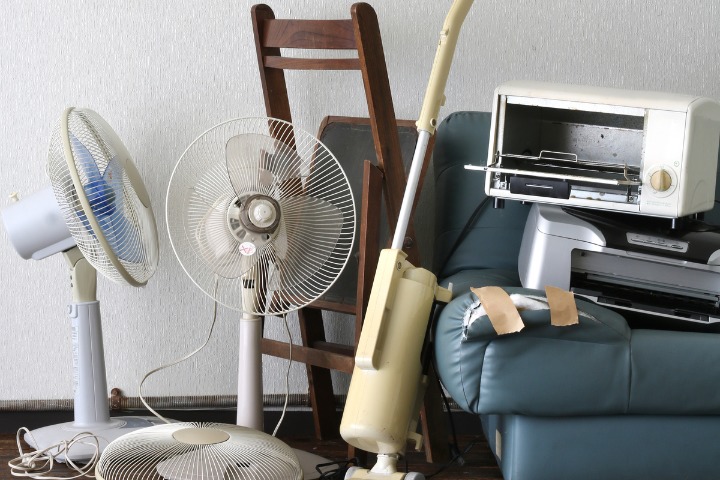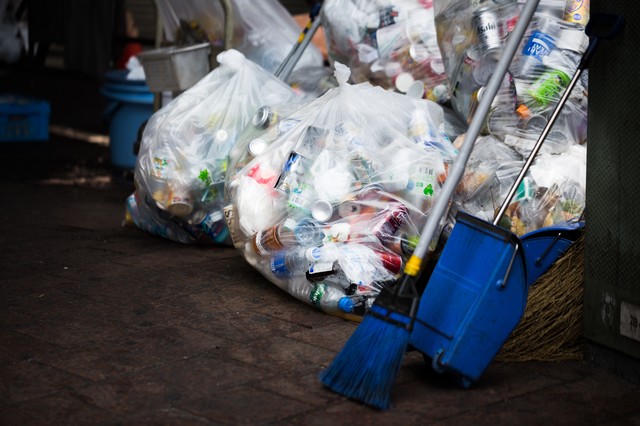Whether you’re a newcomer to Japan, or have been here for a while, the Japanese trash system still remains a little complex! But fear not, if you are looking to find out the difference between all those trash cans, and how to distinguish between moenai gomi and moeru gomi, we’ve got you covered. Read on to understand everything you need to know about Japanese garbage and recycling rules.
Moenai Gomi, Moeru Gomi, Plastics, Cans and More – Deciphering Trash Rules in Japan
もったいない (mottainai) – translated as “what a waste!”- is the common Japanese phrase used to express regret about something being wasted. You may hear it in certain situations during your daily life, or express it yourself when purchasing groceries in the supermarket covered in several layers of plastic.
Japan actually has one of the worst recycling rates out of any OECD (Organisation for Economic Co-operation and Development) country. According to OECD statistics Japan only recycled 19% of its garbage in 2019, and a huge 79% was incinerated.
But this doesn’t mean Japan has no recycling system in place. Each local government has strict garbage and recycling systems that can be difficult to decipher, often resulting in me asking my partner, “これは何ゴミ?” – “what trash would this be classed as?”
When it comes to Tokyo, the regulations are decided by the ward. And the details can be different by city so make sure you find out those in your area. Outside of Tokyo, for example in Kamikatsu-cho, Tokushima prefecture, they divide garbage into over 45 different types with an aim to become completely zero waste!
Read this article on trash outside the home: Why Japanese Take Their Trash Home
Three Tips For Sorting Your Trash

Photo credits: Canva.com
Details depend on each ward, but let’s learn the basic Japanese words to know and rules to follow in the following three steps:
1. Learn the Vocab
ゴミ(Gomi) – Garbage
Gomi is the word for garbage. When you see these two characters ゴミ箱 (gomibako) in public, it means trash can. And most of the time, public trash cans are divided into a few categories, or at least two: 燃えるゴミ(moeru gomi) and 燃えないゴミ(moenai gomi). In English, “burnable” and “nonburnable”. Let’s take a closer look at the division of garbage:
燃えるゴミ (Moeru Gomi) – Burnable Trash
Moeru gomi is the word used for burnable/combustable trash. More often than not it is written as 燃えるゴミ (moeru gomi) but sometimes you will see the Japanese 燃やすゴミ (moeyasui) or 可燃ごみ (kanen gomi) used instead to mean the same thing. This is one of the two main categories of trash you will see. Items that can be incinerated go here, so things like such as food waste, tissues, diapers, small pieces of paper, leather and rubber products, shoes, clothes etc. Surprisingly plastic bags, wrappers used, and dirty food containers are generally also classed as moeru gomi. However, depending on the area, you are generally encouraged to wash your plastic/foam containers to remove any food leftovers and put them in the nonburnable trash instead to be recycled. Dirty food trays cannot be recycled so they remain in the moeru gomi.
燃えないゴミ (Moenai Gomi) – Nonburnable Trash
Moenai gomi means nonburnable/noncombustable trash. It may also appear in Japanese as 不燃ごみ (funen gomi). This is the second of the two main trash categories. Generally, plastic garbage such as meat and fish containers, plastic cords, cooking pots and pans, small electrical appliances such as hair dryers, glass, metal, and chinaware are included here.
If something is broken and fragmented, wrap it with newspaper and write 「キケン」(“kiken”, danger) on the outside and put it in a separate bag. This is to ensure the collectors don’t injure themselves.
生ごみ (Nama Gomi) – Raw (Kitchen) Garbage
Nama gomi is the word for kitchen garbage. You will find vegetable peels, fish bones and leftovers here. The nama gomi will usually be placed into the moeru gomi trash bag to be incinerated.
ペットボトル (Petto Botoru) – PET Bottles
PET bottles are plastic bottles made from polyethylene terephthalate, a form of polyester. This includes the drink bottles you buy from the vending machines and supermarkets and may also include things like shampoo bottles, sauce bottles etc. Look for the symbols chart below to find the symbol that indicates your bottle is a PET bottle. The bottles should be washed and dried, then squashed a little to make them smaller and easier to collect. Caps and labels should be removed and thrown away with the nonburnables. Some cities only take transparent PET bottles so make sure you check. Depending on your area you are generally required to put PET bottles in a plastic bag when throwing them away.
カン (Kan) – Cans
Kan are metal cans. Like PET bottles, can should be washed and dried. They are generally thrown out in plastic bags or just placed in the colour coded plastic boxes on the day of collection.
ビン (Bin) – Glass Bottles
Bin is the word to indicate glass bottles. Again they should be washed, with the caps separated. Some wards/cities prefer the labels to be removed too. Similarly to cans, your area may require them to be in plastic bags or only placed in the plastic box.
資源ゴミ (Shigen Gomi) – Paper Recyclables
Shingen gomi is paper recyclables. Newspapers, magazines, cartons and cardboard should be tied together with string. Milk cartons should be washed, dried and folded before tying them with string. If you don’t have any string you can place the smaller items tidily in paper bags. These are generally set out in the trash collection location without plastic bags.
粗大ゴミ (Sodai Gomi) – Oversized Garbage
Sodai gomi is an expansive category that can be translated as “oversized garbage”. It generally relates to trash larger than 30cm in width. For example, large appliances, furniture etc. In other countries, getting rid of such trash can mean a trip to the dump, but Japan’s sodai gomi system is a bit more complicated. And you have to pay for it. When you move house, it can mean a bit of a headache as you will have to remove all furniture and appliances from your place because Japanese apartments are rented/sold empty.

Photo credits: Canva.com
To dispose of sodai gomi not only do you have to pay for it, but you also have to procure a time slot for it to be collected. If you wanted to throw away a table, for example, you would have to apply for its removal through the ward. After the collection appointment is made, you will be told which stickers 粗大ごみ処理券 (sodai gomi shori ken) you will need to purchase from the convenience store. After you’ve purchased these, you stick them onto the item and leave it outside during the specified time. Phew!
Symbols to Look Out For:
Here are some symbols you’ll find on packed items in Japan that will help you determine what they are made from:
 Paper (紙, Kami)
Paper (紙, Kami)
 Plastic (プラ, Pura)
Plastic (プラ, Pura)
 Aluminium (アルミ, Arumi)
Aluminium (アルミ, Arumi)
 Steel (スチール, Suchiiru)
Steel (スチール, Suchiiru) PET Bottles
PET Bottles
2. Learn When and Where to Dispose the Trash
When it comes to house garbage, you must follow the schedule of what days you can put out your trash, where you have to bring it, and what time you have to put it out. Make sure you check the rules and regulations on your chart.
When
The type of garbage that you can dispose of is predetermined. For example, Tuesday and Friday for burnables, Thursday for nonburnables, Saturday for PET bottles etc. Usually when you move in you will be given a chart that shows the schedule. It will be written in Japanese with the days of the week shortened to: 月・火・水・木・金・土・日 (getsu, ka, sui, moku, kin, do, nichi) for Monday to Sunday.
The time will also be written on your schedule (usually it’s around 8 or 8:30 am), so make sure you put your trash out before the time indicated.
Where
Also, the place you must bring the bag is predetermined and if you look around outside you will find your nearest spot – if you have doubts you can ask your landlord or real estate agent when you move in. If you live in a マンション (mansion, large complexes of apartments sadly not to be confused with the English word “mansion”) it’s likely your trash collection point is inside somewhere, maybe there is a collection room in the basement. If you live in a house or アパート(smaller apartment buildings) the point will often be outside, indicated by a trash schedule, and maybe a net. If it’s sodai gomi you can usually leave it outside your house but check the instructions given.
3. Learn Any Additional Rules
Photo credits: Pakutaso.com
Garbage Bags
In some regions, even the color and size of plastic garbage bag is regulated.
透明 (toumei) means transparent and, 半透明 (hantoumei) means translucent. Generally the colors are 白(shiro, white) or 黒 (kuro, black). The appropriate size could be 45L bag or a 70L bag and so on.
Keep the Crows Away!
If your trash collection point is outside, you may have green nets covering the bags to protect them from crows. If so, make sure you place the bag completely under the weighted net. I recently moved and was surprised to find no net, but instead, all my neighbours had set out 50L plastic trash bins with their plastic trash bags inside. This was the first time I saw trash cans outside in Japan. I incorrectly assumed this was obligatory and when I put my trash bag out it was attacked by crows and I received a note on my door telling me to buy a trash bin for the following week…oops.
Other Things to Remember
Also, in addition to the above restrictions, and writing “キケン“ on broken glass, remember that if you want to dispose of oversized garbage, you will need to buy stickers that are sold at convenience stores, pharmacies and supermarkets.
Sort, Recycle, Throw Away Your Moeru Gomi With Peace of Mind
Once again, please keep in mind that rules and restrictions are different for each region. Some places are very strict, some are not so much. But in any case, remember the spirit of “mottainai” and have an eco-friendly, clean life in Japan!
Shizuka Sakamoto and Guidable Writers
More tips on life in Japan:
- Why Japanese Take Their Trash Home
- A Guideline About Taxes in Japan For Foreigners
- Etiquette For Visiting A Japanese Home: Useful Terms And How To Behave







